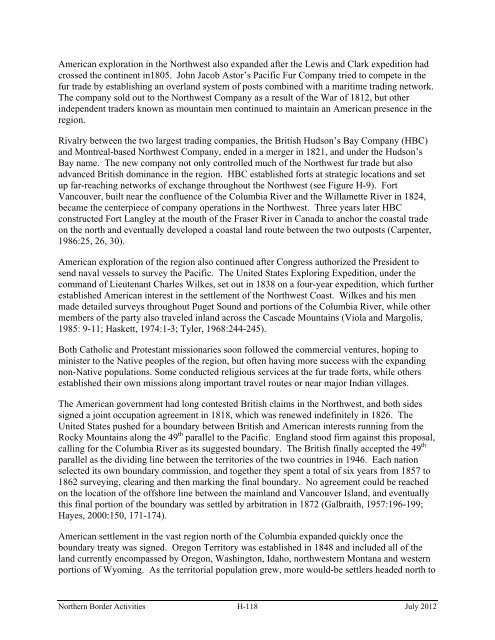Appendix H - Historical Archaeological and ... - CBP.gov
Appendix H - Historical Archaeological and ... - CBP.gov
Appendix H - Historical Archaeological and ... - CBP.gov
You also want an ePaper? Increase the reach of your titles
YUMPU automatically turns print PDFs into web optimized ePapers that Google loves.
American exploration in the Northwest also exp<strong>and</strong>ed after the Lewis <strong>and</strong> Clark expedition had<br />
crossed the continent in1805. John Jacob Astor’s Pacific Fur Company tried to compete in the<br />
fur trade by establishing an overl<strong>and</strong> system of posts combined with a maritime trading network.<br />
The company sold out to the Northwest Company as a result of the War of 1812, but other<br />
independent traders known as mountain men continued to maintain an American presence in the<br />
region.<br />
Rivalry between the two largest trading companies, the British Hudson’s Bay Company (HBC)<br />
<strong>and</strong> Montreal-based Northwest Company, ended in a merger in 1821, <strong>and</strong> under the Hudson’s<br />
Bay name. The new company not only controlled much of the Northwest fur trade but also<br />
advanced British dominance in the region. HBC established forts at strategic locations <strong>and</strong> set<br />
up far-reaching networks of exchange throughout the Northwest (see Figure H-9). Fort<br />
Vancouver, built near the confluence of the Columbia River <strong>and</strong> the Willamette River in 1824,<br />
became the centerpiece of company operations in the Northwest. Three years later HBC<br />
constructed Fort Langley at the mouth of the Fraser River in Canada to anchor the coastal trade<br />
on the north <strong>and</strong> eventually developed a coastal l<strong>and</strong> route between the two outposts (Carpenter,<br />
1986:25, 26, 30).<br />
American exploration of the region also continued after Congress authorized the President to<br />
send naval vessels to survey the Pacific. The United States Exploring Expedition, under the<br />
comm<strong>and</strong> of Lieutenant Charles Wilkes, set out in 1838 on a four-year expedition, which further<br />
established American interest in the settlement of the Northwest Coast. Wilkes <strong>and</strong> his men<br />
made detailed surveys throughout Puget Sound <strong>and</strong> portions of the Columbia River, while other<br />
members of the party also traveled inl<strong>and</strong> across the Cascade Mountains (Viola <strong>and</strong> Margolis,<br />
1985: 9-11; Haskett, 1974:1-3; Tyler, 1968:244-245).<br />
Both Catholic <strong>and</strong> Protestant missionaries soon followed the commercial ventures, hoping to<br />
minister to the Native peoples of the region, but often having more success with the exp<strong>and</strong>ing<br />
non-Native populations. Some conducted religious services at the fur trade forts, while others<br />
established their own missions along important travel routes or near major Indian villages.<br />
The American <strong>gov</strong>ernment had long contested British claims in the Northwest, <strong>and</strong> both sides<br />
signed a joint occupation agreement in 1818, which was renewed indefinitely in 1826. The<br />
United States pushed for a boundary between British <strong>and</strong> American interests running from the<br />
Rocky Mountains along the 49 th parallel to the Pacific. Engl<strong>and</strong> stood firm against this proposal,<br />
calling for the Columbia River as its suggested boundary. The British finally accepted the 49 th<br />
parallel as the dividing line between the territories of the two countries in 1946. Each nation<br />
selected its own boundary commission, <strong>and</strong> together they spent a total of six years from 1857 to<br />
1862 surveying, clearing <strong>and</strong> then marking the final boundary. No agreement could be reached<br />
on the location of the offshore line between the mainl<strong>and</strong> <strong>and</strong> Vancouver Isl<strong>and</strong>, <strong>and</strong> eventually<br />
this final portion of the boundary was settled by arbitration in 1872 (Galbraith, 1957:196-199;<br />
Hayes, 2000:150, 171-174).<br />
American settlement in the vast region north of the Columbia exp<strong>and</strong>ed quickly once the<br />
boundary treaty was signed. Oregon Territory was established in 1848 <strong>and</strong> included all of the<br />
l<strong>and</strong> currently encompassed by Oregon, Washington, Idaho, northwestern Montana <strong>and</strong> western<br />
portions of Wyoming. As the territorial population grew, more would-be settlers headed north to<br />
Northern Border Activities H-118 July 2012
















